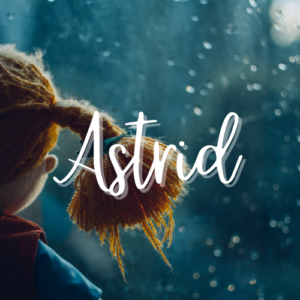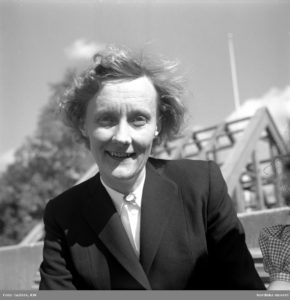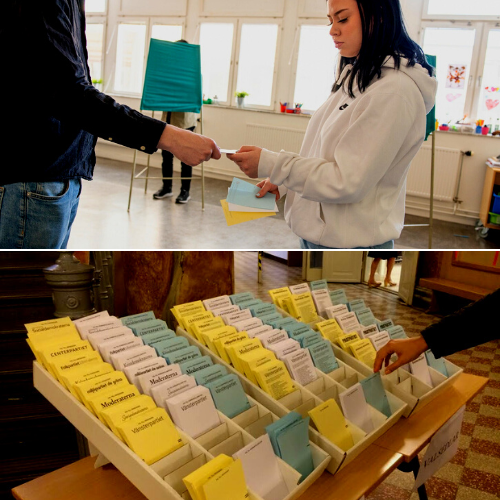Where it all began
Sunday, November 14th, 1907 in Vimmerby Sweden a girl was born by the name Astrid Ericsson. She would grow up to be known as Astrid Lindgren, one of Sweden’s most beloved authors, mostly known for her children’s books. And to celebrate her birthday I wanted to dedicate an episode to her.
As I said she was born on November 14th, 1907 on the farm Näs outside Vimmerby in Småland, Sweden. She died on the 28th of January 2002, in Stockholm, Sweden at the age of 95. She described her childhood as a very happy time, filled with security and freedom. At an early age, she found the love of books and reading, as she and her brother visited their friend Edit, and often sat on the kitchen floor reading stories. This kitchen is also said to be the model of many of the kitchens she would, later on, describe in her own stories.
This is a quote from Astrid where she describes how it felt to read as a kid;
“It was something that engaged your entire being, all your senses, sight, smell, and touch, more intense than any other event in your whole existence as a child.” A new book was “something almost unbearably wonderful”.
After graduating from school Astrid Lindgren was employed by the Vimmerby newspaper as a sixteen-year-old. She proofread, wrote tiny notices and short reports. There she had an affair with the editor-in-chief of the newspaper Reinhold Blomberg which in turn led to her being pregnant at the age of 19 in 1926, which was a scandal at the time, being pregnant and unmarried. Blomberg was at the time married. The rumors around Vimmerby about the scandal led to Astrid leaving Vimmerby and moving to Stockholm.
She gave birth to her son Lasse in December 1926, after traveling to Copenhagen Denmark, where she stayed with a family that would take care of Lasse as she returned to Stockholm until she was ready to bring him back to live with her.
After returning to Stockholm she went to school to become a secretary, and in 1928 Astrid got a job at the Royal Automobile Club (KAK). Her boss at this time, Sture Lindgren, would later become her husband. In 1929 Astrid had to bring Lasse back to Stockholm to live with her after the woman he had been living with (and saw as his family) got sick, and this was a devastating experience for him. Astrid has later said that this experience and Lasses tears when he realized that he was not going back to Copenhagen, probably are the reason for her being so quick to take the side of a child in any circumstance. After Lasse was sick with whooping cough he moved to his grandparents on the farm in Vimmerby and lived there until Astrid married Sture Lindgren in 1931, when he moved back to them and even took the last name, Lindgren.
At this point, Astrid stopped working and became a homemaker. And in 1934 she got her daughter Karin.
Karin became sick in 1941, and to comfort her Astrid started to tell her stories about Pippi Longstocking. These stories would eventually be her first chapter book.

Her Books
Astrid Lindgren has written 34 original chapter books and 41 picture books. Her books have sold 165 million copies and have been translated into over 100 languages, and many have been made into movies worldwide.
In 1944 she won second prize in a competition by Rabén& Sjögren ( a Swedish publishing company) with her novel Britt-Marie Lättar Sitt Hjärta (Britt-Marie Unberden Her Heart), and the year after she won first prize in the same competition with her chapter book Pippi Långstrump (Pippi Longstocking). Interesting to know about Pippi Longstocking is that she first submitted the manuscript to Albert Bonnier’s publishing company, which refused it. When she, later on, let her editor, Elsa Olenius, at Rabén& Sjögren read her manuscript of Pippi Longstocking Elsa suggested some re-writing, she submitted it to their contest and won first prize and Rabén& Sjögren became her publisher. This also lead to Astrid being employed by Rabén& Sjögren. In 1946 Astrid was made responsible for children’s fiction and as such took on double roles as a writer and as an editor.
From this moment on, she was one of the most appreciated authors in Sweden. Even though there has been some criticism and critique of her books and her main characters she has won a series of national and international prizes for her work.
With the huge amount of books, and characters, that she brought to life with her books it is almost impossible to pick some favorites, but I will do my best. You have probably heard of Pippi Longstocking (Pippi Långstrump) this strangely dressed girl living alone with her horse and ape, with a suitcase full of gold and so strong that she can carry her horse. A definite favorite of mine, whit its humor and rebellious manner of Pippi herself. But these books have also been criticized for their racist content.
Another favorite is Emil i Lönneberga (Emil in the Soup Terrin) from 1963. Another non-conforming child who wanted to do what was right but always ended up doing something he shouldn’t and was punched by spending time in the carpenter’s shop where he carved his wooden people as he was reflecting on his mistakes.
But maybe my three most beloved books by Astrid fall within the folklore/fantasy realm with Mio, min Mio (1954; Mio, My Son), Bröderna Lejonhjärta (1973; The Brothers Lionheart), and Ronja Rövardotter (1981; Ronia, the Robber’s Daughter). Books that tap into feelings and hardship, about growing up and accepting difficulties in life, and of empowerment.
Especially The Brother’s Lionheart is close to my heart with its depiction of the fight between good and evil, courage and fear, and love and death. The opening words of the book will always take me back to when I used to read aloud to my students back in Sweden. The anticipation from the students, and the joy of sharing this experience with them. So let me read you the very first lines of the book:
Now I’m going to tell you about my brother. My brother, Jonathan Lionheart, is the person I want to tell you about. I think it’s almost like a saga, and just a little like a ghost story, and yet every word is true, though Jonathan and I are probably the only people who know that.
Jonathan’s name wasn’t Lionheart from the start. His last name was Lion, just like Mother’s and mine. Jonathan Lion was his name. My name is Karl Lion and Mother’s is Sigrid Lion. Father was Axel Lion, but he went to sea and we never heard from him since.
But what I was going to tell you was how it came about that my brother Jonathan became Jonathan Lionheart, and all the strange things that happened after that.
Appreciated all over the world

Av K.W. Gullers/Nordiska museet.
Lisens: CC BY NC ND 4.0
Throughout her life, she consistently opposed injustice and oppression. Her engagement in children’s rights issues was formed early on. An unbroken and consistent thread runs through Astrid Lindgren’s entire work; the fight for every child’s right to love and safety.
To memorate what would have been her 100 birthday in 2007 a collection was started to build an Astrid Lindgren Children’s Village together with SOS Children’s Villages. In 2009 her children’s village was completed. 120 children have been given a new family and the school and nursery provide education to hundreds of children.
Of course, she has been recognized for her work during her life and she has been awarded more than 100 prizes worldwide, among those are:
1971 The Swedish Academy’s Grand Gold Medal
1978 German Booksellers’ Peace Prize, Germany
1986 Swedish Council of America names Astrid Lindgren, “Swede of the Year”
And some awards in her name the biggest being an international award, created by the Swedish government in 2002, the Astrid Lindgren Memorial Award, a literary prize in memory of Astrid Lindgren that’s handed out annually. The prize is worth five million SEK, which makes it the world’s biggest international prize for children and young adult literature.
And The Astrid Lindgren Prize was set up in her honor on her 60th birthday in 1967. The prize is awarded annually for significant authorship in children’s and youth literature.
In 2015 Astrid Lindgren and Pippi Longstocking adorn the new Swedish 20 crown banknote.
A political force
Astrid Lindgren also became one of the country’s most important opinion-makers and was part of the political debate in the late 70s and 80s in Sweden, both when it came to taxation policies and the nuclear power referendum.
In 1976 Astrid Lindgren also jumped straight into public political debate. Astrid wrote a big spread article for debate in the form of a fairytale to which she gave the name, Pomperipossa in Monismania. The article was a blistering attack on the Social Democratic government and its taxation policies.
In 1980 it was time for the next big controversial political issue – the Swedish nuclear power referendum. Astrid Lindgren was deeply involved in the issue and became one of the most famous proponents of Option 3 – the proposal that sought to cease using nuclear power, close power stations, and ban uranium mining.
Her words played a significant role in taking down a government and she influenced several Swedish laws both directly and indirectly. For example, for her 80th birthday present, she was given a brand new animal rights law, which is sometimes referred to as “Lex Lindgren”.
Some fun facts
And let me end this with some fun facts about Astrid
On the 1st of September 1978,
the Crimean Astrophysical Observatory discovered an asteroid. In 1996 the asteroid was named by the Russian Academy of Science as “3204 Lindgren” or the “Asteroid Lindgren” after Astrid Lindgren.
1995
The first Swedish satellite is launched and is named “Astrid1” after Astrid Lindgren. Onboard are three instruments named after the characters Pippi, Mio, and Emil.
2002
The Astrid Lindgren Memorial Award (ALMA), the world’s second-largest prize for literature, is instituted by the Swedish government.
As always I hope you enjoyed this episode, and if you haven’t had the pleasure of reading some of Astrid Lindgren’s books already I hope you will. They are children’s books written for both kids and adults.
I hope to see you back next week when I will take a historical look back at Swedes in the US




